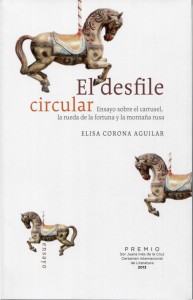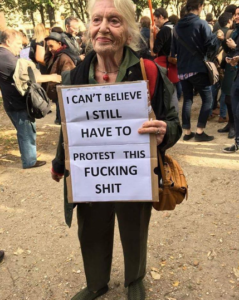
In Toys and Reasons, Erik H. Erikson notes that through time, adults have judged playing and games as neither serious nor useful, and therefore unrelated to central human tasks and motivations. “Such division makes life more simple and allows adults to reject the suggestion, often startling, that play (and, thus, randomness) may occur in the vital center of adult preoccupations, just like it does in the center of childhood preoccupations”.
The history of the concept of play is difficult to track down. However, as Roger Caillois states, games provide us with evidence of human nature’s constancy, since their persistence is notable: “Empires and institutions may disappear, but games survive with the same rules and sometimes even with the same paraphernalia. The main reason is that they are not important – they possess the permanence of the insignificant”.
The play-element is immersed in our culture and is an essential part of it, but like the court jester, is never taken seriously. Play is an occasion merely for waste, says Caillois, “waste of time, of energy, of wit, of skills and, often, of money”: it is a useless activity, unproductive in itself, and in this it shares its essence with Art. Playing is an act of free will, since no one can be forced to play, but once you join, you must respect established rules that have nothing to do with social conventions or the norms of everyday life; in fact, sometimes the rules of the game are directly opposite to those of “real life”.
Among the 20th century’s favorite metaphors for expressing what life resembles, three refer to rides. We say “life is a roller coaster” to speak about a series of unexpected events, the sudden shocks we all face unprepared, the speed of modern world. I have heard the expression especially when big changes are about to happen, as if those who use it were on the highest mountain top, just seconds away from the first euphoric descent. People say “life is a Ferris wheel” to describe the luck and chance that sometimes leads us to success where we can sit side by side with the winners, and sometimes knocks us down to the lowest possible state, next to the unfortunate. But nothing lasts forever. The wheel may turn again, changing the destiny of our hopes and our place in the world. Finally, “life is a merry-go-round” can be heard in all kinds of songs to suggest that through life we spin on the same spot, around certain things, people, important events, in a circular journey which, where it will lead, we can never know. We lose sight of the beginning and the end: it is all about holding tight and enjoying the ride.
Love, as life, is often compared to these rides. Love is a carousel: with its constant spinning it isolates us from the world and allows us to be alone with whoever rides with us, while soft and joyful music is heard as if creating a world apart for the lovers. Love is a Ferris wheel: it takes us high above the clouds to contemplate an immense horizon, a view at first hidden from our eyes. But love can also take us down to the ground, heartbroken. And the image of the roller coaster will be always used in reference to passionate love, beyond our control, out of proportion, that can take us full speed into free falls that may even terrify us.
In his book Homo ludens, Johan Huizinga states that every game, in its free and meaningful sense, is a representation of something. If we follow this assertion, it is not hard to conclude that rides are the representation of a journey: they remove us from everyday life in order to displace us in different ways within a determined time-space intended for this purpose; their ups and downs change our vision of reality, we must accept their twists and turns, we must take the risk from entrance to exit so we can have a new experience, a new exploit to tell before we come back home. In English they are called “rides”, the word tells us clearly we have to ride the machine and complete a certain path, a certain journey on board. And life, like love, is a journey, according to the oldest metaphors of humankind.
It is no surprise that the emergence of rides coincided with the end of the era of exploration, around the second half of the 18th century. When the world stopped being an unknown place full of mysteries, when we ran out of borders (at least apparently), human beings turned their expectations to the subjective journey, the one that can be made through emotions and senses. A new era of explorations was born, but directed to the individual experience, inside the mind of every adventurer. Soon, medical or spiritual reasons would no longer be the only purpose for drug experimentation, which would become a pursuit of pleasure, or as Davenport-Hines describes it, a pursuit of oblivion, of joy. Travel to different countries, to places that changed from being exotic mysteries into territories vanquished by so-called civilization, might offer unbridled sexuality as a promise for an off-the-books adventure – the traveler could feel safe from watchful familiar faces. The brave adventurer, the explorer, the discoverer, became a simple tourist, and as Caren Kaplan says, “tourism is a herald of modernity, a product from the beginning of the culture of consumerism, leisure and technological innovation”.
This representations of the journey – the carousel, the Ferris wheel, the roller coaster – helped motivate the creation of a place within the city intended to get away from routine, to invert the rules and forget about day-to-day behavior: the fair. If we look at a Turkish watercolor painting from the 17th century or if we consult The Travels of Peter Mundy (1608-1667), we find in the descriptions and sketches of Philippopolis (today Bulgaria) that fairs of that time and place are presented very much like modern fairs. Some modern rides even existed in a primitive form: spinning rides that amused by going round and round, vertical wheels with seats that go up and down. In addition, there were musicians who created a joyful atmosphere, and people drinking and walking around, enjoying a ritual distant from the sacred and the political but equally necessary for their society.
It was only in the 19th century that world’s fairs and world expositions in Europe and America became the stage for scientists, artists and business men to exhibit their latest developments: the epitome of civilization and its progress. Additionally, these World’s Fairs promoted the cosmopolitan idea of uniting inhabitants from all around the world: Arab dancers and Eskimos, African magicians and enigmatic Japanese women. Previously, circuses had exhibited recently discovered wild animals as attractions. Then, it was human beings who displayed their exoticism and boasted about their origins and traditions. The ideas that made enemies of the unconquered began to be left behind, or at least, they were left out of the fair, which became a world’s sampler, a space where everybody mingled to be amazed by their differences.
In this context of cosmopolitism and eagerness for novelties, mechanical rides won their place in modern life. Besides giving more activity and movement to the fair, and often demonstrating the technological advances and risky new designs that could be accomplished, rides also opened a new panorama of feelings and behaviors. The fair would become the perfect space for fulfilling many of the ideas of Romanticism. Rides would help to do so by allowing free expression and breaking up familiar conventions. Love, courtship, the fall of racial boundaries, public and uninhibited liberation of the most intense emotions would all take place in the fair, and quite often thanks to these new mechanical rides that confronted their passengers with a new form of perception. There was always provocation and challenge in the act of riding these machines. Those who did it could brag about being brave and daring, two of the most coveted features of big cities’ residents.
Despite being a product of technological innovation and metropolitan amusement, the rides also appealed to the charm of nature’s elements. On the other hand, they also appealed to the creation of a world of fantasy, or a world that resembled that of bygone times allegedly obliterated by modern world. The carousel represented a ride on the back of steeds, jungle animals and even fantastic creatures otherwise inconceivable in the urban world. It evoked a world symbolically and literally distant from the city: the country, the jungle or fairy tale landscapes. With the roller coaster, the connection to nature is evident: a wooden or iron mountain that manages to infiltrate the structure of a city and to appropriate a distinct characteristic of its people’s life: the speed of events, their intensity, and the uncontrolled impulse towards the future. The Ferris wheel with its countless mystic allusions, seemingly unrelated to nature, revealed to its passengers a new form of enjoying a product recently offered to tourism and so cherished by romantic poets: the landscape.
Besides this consistent element of integrating nature, artificially or symbolically, into the structure of the city, and thus helping the creation of the “concrete jungle”, the appearance and decoration adopted by the rides seemed to tie together both ancient and modern elements. The carousel, with its rococo, shiny, and artificial aesthetic, enveloped us in fairy tales or the splendor of baroque churches. At nights, the Ferris wheel became a spectacle in itself the moment someone decided to cover it with incandescent bulbs, turning it into a luminous cobweb in the sky. The roller coaster presented attractions from all over the world during the course of the ride: Egyptian pyramids, Swiss Alps, and grottos, proving that the most characteristic sights of the planet could be condensed into a short and intense journey.
Very few pleasures are as universal as these three rides. They have succeeded in becoming a part of every culture and society without any resistance. They adapt to all contexts and insert themselves into all social conventions. They seem inherent to our own nature. Because of that, they seem to have suddenly emerged everywhere, without any specific origin, without anyone in particular who decided to invent them.
Nowadays, these rides are far from losing popularity and they continue in several forms as cultural obsessions. The race for building the tallest Ferris wheel, beginning in the 1980s in Japan, seems never to end. The Eye of London, at 443 feet, held first place from its opening in the year 2000 until 2006, when the Star of Nachang in China surpassed it by 82 feet. The Singapore Flyer in 2008 surpassed the Nanchang Star, but only by 16.5 feet. The period a Ferris wheel can remain the tallest of the world is short. The most recent project is in Staten Island, New York City, where construction was planned (at least before Hurricane Sandy in 2012) of a 625 feet tall Ferris wheel. Every new roller coaster is intended to be faster and more complex, to offer emotions more intense than ever. They have changed from “roller coasters” to “Mega Coasters” or even “Mega Hyper Coasters”, with completely vertical ups and downs, simulating not only freefall from a mountain top but a rocket launching into space. The carousel has experienced something different, since what is wanted from it is not improvement or modification, but the restoration of original roundabouts from the so-called “Golden Age” of the carousel. It is intended to be kept as a museum exhibit, an immense music box. The best example is Jane’s Carousel, in Brooklyn, restored together with its pipe organ and going round and round within glass walls on the East River waterfront. The craftsmen who first carved horses and animals on the carousel’s wood are now considered artists who were underappreciated in their time. The price of the original items has increased, and it is a collector’s obsession to obtain one and restore it as closely to the original as possible. The carousel awakens the nostalgia, the longing for past times proper to its own melodious, childhood-addressed nature.
We are more than beings of reason, according to Huizinga, since play is irrational. And great men of science and reason, business and technology served the irrational when building these rides. The stories of the early inventors, their work and the trying times they faced when building these remarkable innovations are little remembered. There are only a few reference books dedicated to these inventions, all of them based on old sketches, photographs, newspapers and patents. And we can count even fewer texts venturing interpretations of the reasons for the rides, and why their success has continued until today, to the point that we keep going to them in theme parks and we keep comparing them with life itself. Being on board these rides sets us free and helps us see things in a new light, it shows us a new landscape and allows secrets of our inner life to escape. Some people become addicts. Some cannot withstand the vertigo they provoke. But no one can remain indifferent to their constant presence and influence in our culture. They are there, they offer us a pleasure that is out of ordinary but so universal that it makes us feel more human, a pleasure that releases us from everyday rules and from our own personal boundaries, in order to send us into an apparently brief journey from which we always come back transformed.
Translated by Luis Miguel Estrada
Edited by Tony Geballe










